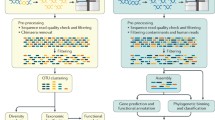Abstract
About 100 trillion microorganisms compose the microbiome of the gastrointestinal tract and are predominantly found within the colon. Until recently, few bacteria were thought to inhabit the normal healthy esophagus and stomach. However, contemporary studies using molecular techniques have contradicted these assumptions. In this review, we summarize the pertinent findings of these studies that demonstrate established, complex mixed-microbial communities within the foregut in both health and disease. These studies contribute to improved understanding of interactions between the host immunity and the microbiome that may ultimately allow for novel therapeutic targets.
Similar content being viewed by others
References
Papers of particular interest, published recently, have been highlighted as:•• Of major importance
DiBaise JK, Zhang H, Crowell MD, et al.: Gut microbiota and its possible relationship with obesity. Mayo Clin Proc 2008, 83:460–469.
Ley RE, Peterson DA, Gordon JI: Ecological and evolutionary forces shaping microbial diversity in the human intestine. Cell 2006, 124:837–848.
Backhed F, Ding H, Wang T, et al.: The gut microbiota as an environmental factor that regulates fat storage. Proc Natl Acad Sci U S A 2004, 101:15718–15723.
Guarner F, Malagelada JR: Gut flora in health and disease. Lancet 2003, 361:512–519.
Kassinen A, Krogius-Kurikka L, Makivuokko H, et al.: The fecal microbiota of irritable bowel syndrome patients differs significantly from that of healthy subjects. Gastroenterology 2007, 133:24–33.
Gagliardi D, Makihara S, Corsi PR, et al.: Microbial flora of the normal esophagus. Dis Esophagus 1998, 11:248–250.
Pajecki D, Zilberstein B, dos Santos MA, et al.: Megaesophagus microbiota: a qualitative and quantitative analysis. J Gastrointest Surg 2002, 6:723–729.
•• Bik EM, Eckburg PB, Gill SR, et al.: Molecular analysis of the bacterial microbiota in the human stomach. Proc Natl Acad Sci U S A 2006, 103:732–737. This landmark study reports the first detailed analysis of the stomach using 16S-rDNA sequencing technique, demonstrating the complexity of the gastric microbiome.
Giannella RA, Broitman SA, Zamcheck N: Gastric acid barrier to ingested microorganisms in man: studies in vivo and in vitro. Gut 1972, 13:251–256.
Feldman M, Friedman LS, Brandt LJ, eds: Sleisenger and Fordtran’s Gastrointestinal and Liver Disease : Pathophysiology, Diagnosis, Management, edn 8. Philadelphia: Saunders; 2006.
•• Li XX, Wong GL, To KF, et al.: Bacterial microbiota profiling in gastritis without Helicobacter pylori infection or non-steroidal anti-inflammatory drug use. PLoS One 2009, 4:e7985. This article describes the gastric microbiome of subjects with gastritis from causes other than H. pylori or NSAIDs using molecular techniques.
Pei Z, Bini EJ, Yang L, et al.: Bacterial biota in the human distal esophagus. Proc Natl Acad Sci U S A 2004, 101:4250–4255.
Pei Z, Yang L, Peek RM Jr, et al.: Bacterial biota in reflux esophagitis and Barrett’s esophagus. World J Gastroenterol 2005, 11:7277–7283.
•• Yang L, Lu X, Nossa CW, et al.: Inflammation and intestinal metaplasia of the distal esophagus are associated with alterations in the microbiome. Gastroenterology 2009, 137:588–597. This study reports findings that show how the complex microbiome of the distal esophagus is different in the presence of esophagitis and Barrett’s esophagus.
Finlay IG, Wright PA, Menzies T, McArdle CS. Microbial flora in carcinoma of oesophagus. Thorax 1982, 37:181–184.
Sjostedt S, Heimdahl A, Kager L, Nord CE: Microbial colonization of the oropharynx, esophagus and stomach in patients with gastric diseases. Eur J Clin Microbiol 1985, 4:49–51.
Aas JA, Paster BJ, Stokes LN, et al.: Defining the normal bacterial flora of the oral cavity. J Clin Microbiol 2005, 43:5721–5732.
Pajecki D, Zilberstein B, Cecconello I, et al.: Larger amounts of nitrite and nitrate-reducing bacteria in megaesophagus of Chagas’ disease than in controls. J Gastrointest Surg 2007, 11:199–203.
Cabre E, Gassull MA. Complications of enteral feeding. Nutrition 1993, 9:1–9.
O'May GA, Reynolds N, Smith AR, et al.: Effect of pH and antibiotics on microbial overgrowth in the stomachs and duodena of patients undergoing percutaneous endoscopic gastrostomy feeding. J Clin Microbiol 2005, 43:3059–3065.
Sjostedt S, Kager L, Heimdahl A, Nord CE: Microbial colonization of tumors in relation to the upper gastrointestinal tract in patients with gastric carcinoma. Ann Surg 1988, 207:341–346.
Dicksved J, Lindberg M, Rosenquist M, et al.: Molecular characterization of the stomach microbiota in patients with gastric cancer and in controls. J Med Microbiol 2009, 58:509–516.
Disclaimer
The views expressed in this article are those of the authors and do not necessarily reflect the official policy or position of the Department of the Navy, Department of Defense, or the United States Government.
Disclosure
No potential conflict of interest relevant to this article was reported.
Author information
Authors and Affiliations
Corresponding author
Rights and permissions
About this article
Cite this article
Lawson, R.D., Coyle, W.J. The Noncolonic Microbiome: Does it Really Matter?. Curr Gastroenterol Rep 12, 259–262 (2010). https://doi.org/10.1007/s11894-010-0111-6
Published:
Issue Date:
DOI: https://doi.org/10.1007/s11894-010-0111-6




